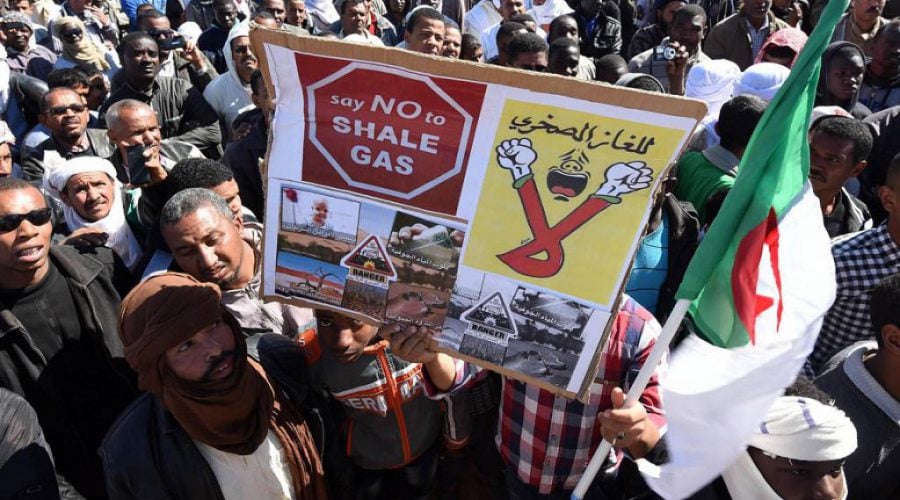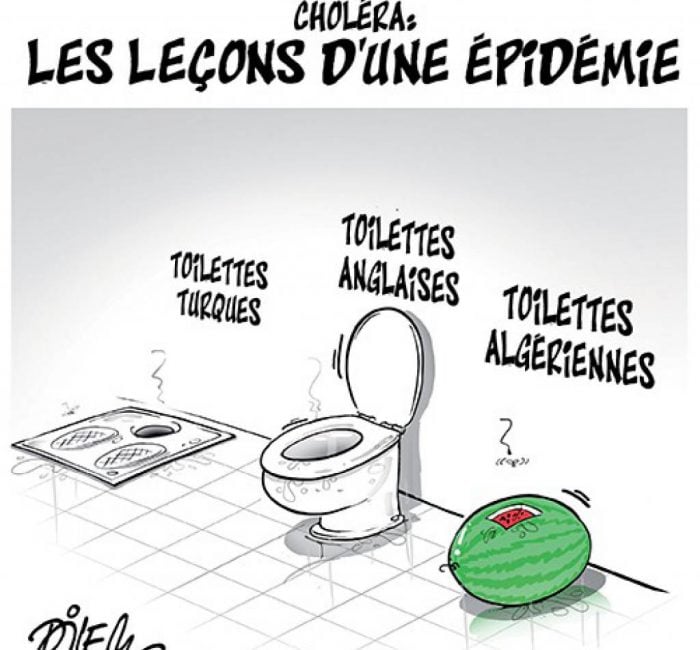
Socio-economic development and rapid urbanization have had a detrimental impact on the quality of water resources, and industrial and urban pollution has been observed in dams, groundwater and rivers.[1] Although Algeria recognizes the polluted state of its water resources, no clear action has yet been taken at a national level.
Surface water quality
According to the National Agency of Water Resources, significant sections of rivers in the Tafna, Macta, Cheliff, Soummam and Seybous basins are polluted. Most of these surface waters are polluted by uncontrolled and untreated municipal and industrial wastewater due to either a bad connection or non-functioning wastewater treatment plants. Untreated sewage or low-quality treated effluents amounting to about 200 MCM are discharged annually directly into natural waterbodies. Phosphorus, nitrates and pesticides have also been detected in some surface waters as a result of improper agricultural management practices.[2]
Groundwater quality
According to the Agence de Bassin Hydrographique’s national plan to monitor water quality in the country’s aquifers, groundwater quality is generally good. However, some changes have occurred due to both natural causes and anthropogenic activities. [3]
In the north, most groundwater is non-saline, with salinity values less than 1 gram per litre (g/l). However, some coastal aquifers in Mitidja and Bas Sebaou suffer from seawater intrusion due to their high permeability and overexploitation. In the southern Sahara, salinity levels are variable and can reach up to 9 g/l in the Complex Terminal. Salinity also increases in aquifers surrounding saline lakes.[4][5]
Anthropogenic pollution of groundwater is commonly observed in aquifers in the north. The large volume of domestic and industrial wastewater discharged daily into the wadis continues to constitute a real threat to groundwater sources, with low levels of dissolved oxygen being noted. Similar cases are also observed in the south, where the wastewater treatment facilities cannot accommodate the entire effluent. Finally, despite intensive farming in rural areas, nitrate concentrations in groundwater generally remain below acceptable levels.[6][7]
Links between shale gas exploitation and deterioration of water resources have been established globally. As a result, shale gas exploitation in Algeria in 2015 saw strong public opposition. A few days after the inauguration of the first exploratory drilling near the city of In Salah, the local population marched with the support of its scientists and activists to prevent the local aquifer from being irreversibly polluted[8] The movement succeeded in slowing down the project implementation, although recent negotiations with American companies have been resumed to reopen shale gas exploitation drilling sites[9]
Sanitation and wastewater treatment network
Sanitation remains a challenging aspect of water management, with an estimated volume of discharged wastewater of around 1.2 BCM/yr.[10]
The implementation of a national sewage network program saw the length of the network increase from 21,000 km in 1995 to 41,000 km in 2011.
| Year | 1999 | 2005 | 2010 | 2013 | 2020 |
| Number of waste water treatment plants | 33 | 34 | 112 | 145 | 239 |
| Capacity (MCM/yr) | 90 | 160 | 665 | 800 | 1,200 |
Table 1: Evolution of wastewater treatment plants from 1999 to 2020.
This has ensured that almost 86% of the total population is connected to the network, with the percentage reaching 90% in urban areas and 82% in rural areas.[11] The aim is to extend the network to 54,000 km by 2020 to keep pace with population growth.[12]
In 2011, the sanitation infrastructure consisted of 134 sewage treatment plants with a total treatment capacity of 700 MCM/yr. A target of an additional 100 treatment plants by 2020 was set, which will increase the treatment capacity enough to achieve 100% treatment of the produced wastewater (Table 1).[13][14]
Environmental and health risks
A lack of integrated water management is exacerbating environmental and health risks across the country.
The declining water quality is acquiring worrying proportions, particularly in the north. Uncontrolled agricultural practices cause water quality degradation through return flows. In urban areas, water supply is at risk of biological and physico-chemical pollution because of the illegal and uncontrolled effluents in the waterways and waterbodies. This risk is amplified by outdated wastewater treatment plants that are not equipped to treat water polluted with heavy metals and pesticides.
Salinization is also a recurring issue that poses challenges for the management of water supply. Certain regions in the west of the country are mainly affected by high salinization rates, which have irreversibly degraded the irrigated agricultural plains. In the south, excessive pumping and uncontrolled irrigation are further salinizing the naturally saline soils and aquifers of the Complex Terminal. In coastal areas such as Oran, Algiers and Jijel, overexploitation of coastal aquifers is resulting in irremediable salt intrusion.[15][16]
Soil erosion is another major environmental challenge. In 2000, nearly 7.5 million hectares of land in the steppe zone were threatened by desertification and wind erosion. Water erosion threatens 12 million hectares in mountainous areas. There, soil erosion has resulted in siltation of dams, which has caused a reduction of 1.2 BCM in the storage capacity of surface reservoirs.[17]
Waterborne diseases have occasionally been reported, which pose a health risk that the authorities cannot always control. In 2018, 76 cholera cases were reported in six coastal provinces. Such outbreaks are typically a consequence of the old leaky sanitation infrastructure that contaminates water used for irrigation.[18]
[1] Bouchekima B, Bechki D, Bouguettaia H, Boughali S and Tayeb Meftah M, 2008. ‘The underground brackish waters in South Algeria: Potential and viable resources’. Laboratoire de Développement des Energies Nouvelles et Renouvelables dans les Zones Arides Sahariennes, Université de Ouargla.
[2] British Geological Survey, 2018. Africa Groundwater Atlas: Hydrogeology of Algeria.
[3] Food and Agriculture Organization of the United Nations, 2009. Groundwater Management in Algeria: Draft Synthesis Report.
[4] Safar-Zitoun M, 2018. Plan National Secheresse Algerie: Deuxième Version. Convention des Nations Unies de Lutte contre la Désertification.
[5] Mozas M and Ghosn A, 2013. État des lieux du secteur de l’eau en Algérie. IPEMED.
[6] Jacobs C and van ‘t Klooster C, 2012. Water and agriculture in the Maghreb. Alterra, Wageningen-UR.
[7] Ennabli M, 2005. Mediterranean Environmental Technical Assistance Program, Water Quality Management: Algeria.
[8] Agence de Bassin Hydrographique, 2009. Qualité des eaux souterraines dans les bassins du Kebir-Rhumel, de la Seybousse et de la Medjerda-Mellegue, 2004-2007. Cahiers de l’Agence.
[9] Aylan B, 2019. ‘Malgré la revolution l’Algérie veut exploiter le gaz de schiste avec une société américaine’. Observ’Algérie.
[10] Sattar AA and Demmak AM, 2014. Algeria Water Sector M&E Rapid Assessment Report. MEWINA: Algeria Water Sector Monitoring.
[11] Xinhua, 2011. ‘Algeria’s drinking water supply increases by 3 times within a decade’.
[12] WASHwatch, 2019. Algeria.
[13] UNICEF and World Health Organization, 2015. Progress on Sanitation and Drinking Water – 2015 Update and MDG Assessment.
[14] Sattar AA and Demmak AM, 2014. Algeria Water Sector M&E Rapid Assessment Report. MEWINA: Algeria Water Sector Monitoring
[15] Safar-Zitoun M, 2018. Plan National Secheresse Algerie: Deuxième Version. Convention des Nations Unies de Lutte contre la Désertification.
[16]Sarraf M, 2004. Cost of Environmental Degradation. METAP (Mediterranean Environmental Technical Assistance Program). World Bank.
[17] Remini B, 2010. ‘La problématique de l’eau en Algérie du Nord’. Larhyss Journal, 8:36
[18]European Centre for Disease Prevention and Control, 2018. Rapid risk assessment: Cholera outbreak in Algeria, 2018.IPEMED.

